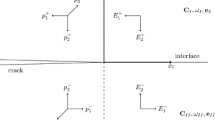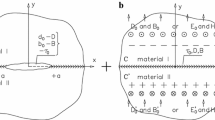Abstract
This paper presents an analysis of crack problems in homogeneous piezoelectrics or on the interfaces between two dissimilar piezoelectric materials based on the continuity of normal electric displacement and electric potential across the crack faces. The explicit analytic solutions are obtained for a single crack in an infinite piezoelectric or on the interface of piezoelectric bimaterials. For homogeneous materials it is found that the normal electric displacement D2, induced by the crack, is constant along the crack faces which depends only on the remote applied stress fields. Within the crack slit, the perturbed electric fields induced by the crack are also constant and not affected by the applied electric displacement fields. For bimaterials, generally speaking, an interface crack exhibits oscillatory behavior and the normal electric displacement D2 is a complex function along the crack faces. However, for bimaterials, having certain symmetry, in which an interface crack displays no oscillatory behavior, it is observed that the normal electric displacement D2 is also constant along the crack faces and the electric field E2 has the singularity ahead of the crack tip and has a jump across the interface. Energy release rates are established for homogeneous materials and bimaterials having certain symmetry. Both the crack front parallel to the poling axis and perpendicular to the poling axis are discussed. It is revealed that the energy release rates are always positive for stable materials and the applied electric displacements have no contribution to the energy release rates.
Similar content being viewed by others
References
Barnett, D.M. and Lothe, J. (1975). Dislocations and line charges in anisotropic piezoelectric insulators. Physica Status Solidi(b) 67, 105–111.
Deeg, W.F.J. (1980). The Analysis of Dislocation, Crack, and Inclusion Problems in Piezoelectric Solids, PhD Thesis, Stanford University.
Dunn, M.L. (1994). The effects of crack face boundary conditions on the fracture mechanics. Engineering Fracture Mechanics 48, 25–39.
Dunn, M.L. and Taya, M. (1994). Electricelastic field concentrations in and around inhomogeneities in piezoelectric solids. Journal of Applied Mechanics. 61, 474–475.
Erdogan, F., Gupta, G.D. and Cook, T.S. (1973). Numerical solution of singular integral equation, in Mechanics of Fracture, Vol. 1, 368–425 (Edited by G.C. Sih), Noordhoff International Publishing, Leyden.
Gao, H.J., Zhang, T.Y. and Tong, P. (1997). Local and global energy release rates for an electrically yielded crack in a piezoelectric ceramic. Journal of Mechanics and Physics of Solids 45, 491–510.
Han, X.L. and Wang, T.C. (1988). Interacting multiple cracks. Key Engineering Materials, Vols. 145–149, 381–386.
Hao, T.H. and Shen, Z.Y. (1994). A new electric boundary condition of electric fracture mechanics and its application. International Journal of Engineering Fracture Mechanics 47, 793–802.
McMeeking, R.M. (1989). Electrostructive forces near crack-like flaws. International Journal of Engineering Science 40, 615–627.
Pak, Y.E. (1990). Crack extension forces in a piezoelectric material. Journal of Applied Mechanics 57, 647–653.
Pak, Y.E. and Herrmann, G. (1986). Conservation laws and the material momentum tensor for the elastic dielectric. International Journal of Engineering Science 24, 1365–1374.
Pak, Y.E. and Tobin, A. (1993). On the electric field effects in fracture of piezoelectric materials. Mechanics of Electromagnetic Materials and Structures, AMD-Vol. 161/MD-Vol. 42, ASME.
Park, S. and Sun, C.T. (1995). Fracture criteria for piezoelectric materials. Journal of American Ceramic Society 78, 1475–1480.
Parton, V.Z. (1976). Fracture mechanics of piezoelectric materials. Acta Astronautica 3, 671–683.
Pohanka, R.C. and Smith, P.L. (1987). In Electronic Ceramics (Edited by L.M. Levinson). Marcel Dekker, Inc., New York.
Sosa, H. (1992). On the fracture mechanics of piezoelectric solids. International Journal of Solids and Structures 29, 2613–2622.
Sosa, H. and Khutoryansky, N. (1996). New developments concerning piezoelectric materials with defects. International Journal of Solids and Structures 33, 3399–3414.
Sosa, H.A. and Pak, Y.E. (1990). Three-dimensional eigenfunction analysis of a crack in a piezoelectric material. International Journal of Solids and Structures 26, 1–15.
Suo, Z. (1993). Models for breakdown-resistant dielectric and ferroelectric ceramics. Journal of Mechanics and Physics of Solids 41, 1155–1176.
Suo, Z., Kuo, C.M., Barnett, D.M. and Willis, J.R. (1992). Fracture mechanics for piezoelectric ceramics. Journal of Mechanics and Physics of Solids 40, 739–765.
Wang, B. (1992). Three-dimensional analysis of a flat elliptical crack in piezoelectric material. International Journal of Engineering Sciences 30, 781–791.
Wang, Z.K. and Huang, S.H. (1995). Fields near elliptical crack in piezoelectric ceramics. Engineering Fracture Mechanics 51, 447–456.
Yang, W. and Suo, Z. (1994). Cracking in ceramic actuators caused by electrostriction. Journal of Mechanics and Physics of Solids 42, 649–663.
Yu, S.W. and Qin, Q.H. (1996). Damage analysis of thermopiezoelectric properties: Part I: Crack-tip singularities. Theory of Applied Fracture Mechanics 25, 263–277.
Zhang, T.Y. and Hack, J.E. (1992). Mode III cracks in piezoelectric materials. Journal of Applied Physics 71, 5865–5870.
Zhang, T.Y. and Tong, P. (1996). Fracture mechanics for a mode III crack in a piezoelectric material. International Journal of Solids and Structures 33, 343–359.
Author information
Authors and Affiliations
Rights and permissions
About this article
Cite this article
Wang, T., Han, X. Fracture mechanics of piezoelectric materials. International Journal of Fracture 98, 15–35 (1999). https://doi.org/10.1023/A:1018656606554
Issue Date:
DOI: https://doi.org/10.1023/A:1018656606554




